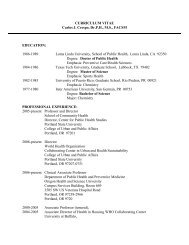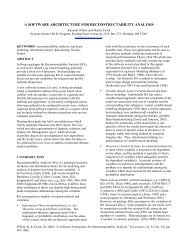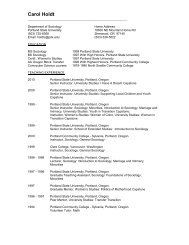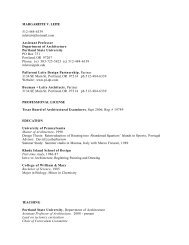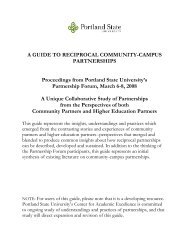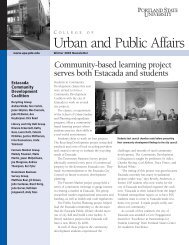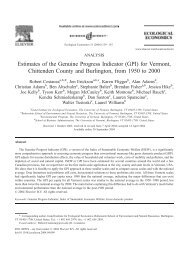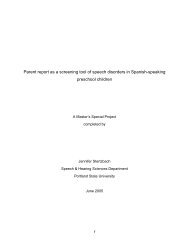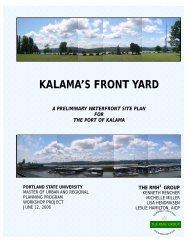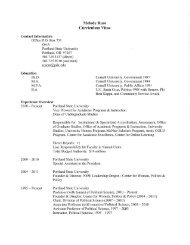international institute on partnerships - Portland State University
international institute on partnerships - Portland State University
international institute on partnerships - Portland State University
Create successful ePaper yourself
Turn your PDF publications into a flip-book with our unique Google optimized e-Paper software.
TUESDAY, MAY 24th<br />
4:30 p.m. to 4:45 p.m. BREAK<br />
4:45 p.m. to 5:30 p.m. INFORMATIONAL PRESENTATIONS BY COMMUNITY/HIGHER EDUCATION PARTNERS<br />
Select <strong>on</strong>e of the eight sessi<strong>on</strong>s outlined below (c<strong>on</strong>tinued next page).<br />
Smith 236<br />
Smith 296<br />
*Cramer 335<br />
Smith 327<br />
Community Engagement in<br />
Overseas Studies: A Partnership<br />
Model<br />
Deepening Levels of Partnership:<br />
Models of Community-based<br />
Research<br />
Diversity in Faculty and<br />
Community Partner Perspectives<br />
about Achieving Reciprocity in<br />
Partnerships<br />
How Can We Enhance<br />
Collaborati<strong>on</strong> between<br />
Researchers and Practiti<strong>on</strong>ers in<br />
the Psychosocial Field<br />
Stanford <strong>University</strong>’s Community<br />
Health in Oaxaca Program, begun<br />
in 2007, incorporates sustained<br />
community-campus <strong>partnerships</strong><br />
that offer students the opportunity<br />
to make meaningful c<strong>on</strong>tributi<strong>on</strong>s<br />
towards meeting local health needs.<br />
Once trust is established, projects<br />
are developed and implemented to<br />
meet partners’ self-identified needs.<br />
Collaborati<strong>on</strong>s are built and sustained<br />
over time based <strong>on</strong> partnership<br />
principles developed by Centers<br />
for Disease C<strong>on</strong>trol, Community-<br />
Campus Partnerships for Health and<br />
others. The <strong>on</strong>going investment and<br />
engagement of Stanford faculty and<br />
staff has played a particularly critical<br />
role. This presentati<strong>on</strong> will illustrate<br />
a replicable model for substantive<br />
community engagement and service<br />
within <str<strong>on</strong>g>internati<strong>on</strong>al</str<strong>on</strong>g> study programs,<br />
and will highlight a multi-year research<br />
collaborati<strong>on</strong> between Stanford medical<br />
students and a not-for-profit supporting<br />
nutriti<strong>on</strong> and agriculture initiatives in<br />
rural Oaxacan communities.<br />
Presenters: Ann Banchoff, Program<br />
Director, Office of Community Health,<br />
Stanford <strong>University</strong><br />
Elizabeth Goldsmith, Medical Student,<br />
Stanford <strong>University</strong> School of Medicine<br />
Campuses resp<strong>on</strong>d to communities<br />
with the capacity to provide<br />
community-based research as a<br />
valued resource and partnership.<br />
The opportunity and challenge facing<br />
campus-community <strong>partnerships</strong><br />
is that there is no <strong>on</strong>e recipe for<br />
how to make them work or how<br />
to design projects in a way that<br />
works for every<strong>on</strong>e. Four projects<br />
at a small liberal arts college are<br />
presented as models of CBR with<br />
degrees of partnership and success<br />
and compared with a university<br />
setting. Projects dem<strong>on</strong>strate different<br />
depths of community engagement,<br />
student learning, and faculty<br />
and administrative involvement.<br />
Implicati<strong>on</strong>s for best practice and<br />
meaningful <strong>partnerships</strong> impact each<br />
project’s value to the community<br />
and to students, and include ethical<br />
c<strong>on</strong>siderati<strong>on</strong>s or tensi<strong>on</strong>s in current<br />
research. Discussi<strong>on</strong> focuses <strong>on</strong> the<br />
unique structure and resources.<br />
Presenter: Judith Owens-Manley,<br />
Director, Center for Civic Engagement and<br />
Learning, <strong>University</strong> of Alaska Anchorage<br />
Challenges inherent in building and<br />
sustaining productive academiccommunity<br />
<strong>partnerships</strong> may<br />
deter researchers from engaging<br />
communities in their research. In a<br />
study of <strong>on</strong>e instituti<strong>on</strong>’s research<br />
<strong>partnerships</strong>, we interviewed faculty<br />
members and their community<br />
partners to assess experiences with<br />
and attitudes toward community<br />
engagement. Our results reveal<br />
dramatic differences in faculty and<br />
community partner perspectives and<br />
underscore areas where academic<br />
researchers may fall short of “walking<br />
the talk” of community-based research.<br />
We will discuss the implicati<strong>on</strong>s of<br />
these findings in terms of strategies<br />
for preparing graduate students<br />
and faculty members to engage<br />
effectively in community-based<br />
interventi<strong>on</strong> research and infrastructure<br />
supports that may improve academic<br />
instituti<strong>on</strong>s’ capacity to resp<strong>on</strong>d to<br />
community needs.<br />
Presenter: Melinda Forthofer, Associate<br />
Professor, <strong>University</strong> of South Carolina<br />
*NOTE: This sessi<strong>on</strong> is in Cramer Hall, not<br />
in SMSU. Please see map.<br />
Research shows that collaborati<strong>on</strong><br />
between researchers and practiti<strong>on</strong>ers<br />
improve receptivity toward researchbased<br />
evidences, and thus increase<br />
the quality of psychosocial services.<br />
However, there is a need to better<br />
understand what determinants and<br />
strategies have to be adopted in order<br />
to enhance collaborati<strong>on</strong> between<br />
research and practice. A critical review<br />
of articles that examine strategies<br />
and determinants associated with<br />
research-practice collaborati<strong>on</strong> was<br />
c<strong>on</strong>ducted with key databases. A<br />
c<strong>on</strong>ceptual framework was then<br />
developed in order to represent the<br />
principal determinants and strategies<br />
retrieved from the literature review.<br />
To illustrate how those determinants<br />
and strategies can be applied, a case<br />
study will be discussed. This case<br />
illustrates an interventi<strong>on</strong> that was<br />
implemented in a Youth center in order<br />
to increase collaborati<strong>on</strong> between<br />
researchers and practiti<strong>on</strong>ers and to<br />
assist the organizati<strong>on</strong> in shifting to an<br />
evidence-based approach to m<strong>on</strong>itor its<br />
programs.<br />
Presenters: Marie-Joelle Gervais, Ph.D.<br />
Candidate, and Francois Chagn<strong>on</strong>,<br />
Universite du Quebec a M<strong>on</strong>treal, Canada<br />
Nico Trocme and Lise Milne, McGill<br />
<strong>University</strong><br />
Gabriel Garcia, Professor of Medicine,<br />
Stanford <strong>University</strong> School of Medicine<br />
Claude Laurendeau, Director of<br />
Professi<strong>on</strong>al Services, Batshaw Youth and<br />
Family Centres<br />
11



